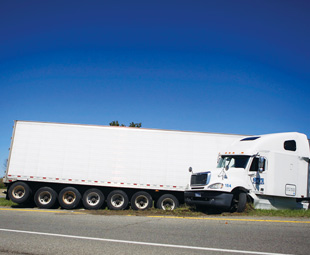Cutting out the jack-knife

The jack-knifing of heavy articulated vehicles on the highways surrounding Johannesburg and Pretoria is becoming a regular occurrence, causing massive traffic delays and frustrated motorists. But who is to blame?
Many of the jack-knifing incidents that occur on our busy highways, in my opinion, are in fact caused by passenger cars and bakkie drivers. How could it be though? Simple … When a frustrated passenger car or bakkie driver, irritated by the slow moving traffic, races past the truck and trailer and then swerves in front of the truck, he fills the safety gap that the truck driver has created in order to be able to stop his rig safely when traffic ahead slows down or stops.
What many passenger car drivers do not realise is that the car or bakkie that he or she is driving has a much shorter stopping distance than a loaded heavy-articulated vehicle.
When the truck driver’s safe stopping gap has been drastically reduced by the irresponsible car or bakkie driver and the traffic suddenly comes to a halt, the truck driver’s natural reaction is to apply brakes and swerve to the left or right to avoid hitting the vehicle in front. The truck tractor is now in a turning position, while the loaded trailer is still moving in a straight line.
This is one of the many situations that could cause the articulated truck to jack-knife.
Other factors, or driver errors, that could cause an articulated rig to jack-knife are when:
• Truck tractor and trailer brakes are not correctly balanced;
• The trailer brakes are no longer functioning due to poor maintenance;
• Incorrect gear selection occurs. This would normally happen when the vehicle is descending a steep hill and the driver changes into a lower
gear (with a gear ratio that is too low
for the speed that the vehicle is
travelling) and then suddenly releases the clutch. The rear-drive wheels
then lock and the trailer continues moving in a straight line resulting in
a jack-knife;
• Operating in very poor weather conditions;
• The driver enters a sharp curve in the road too fast and half way into the curve he applies harsh braking.
Some truck tractors are fitted with a trailer brake hand control which allows the driver to apply the trailer brakes only. This is a good feature to have on a vehicle, if correctly used, as by applying the trailer brakes only it gives that driver the opportunity to immediately correct trailer swing that could result in a jack-knife.
However, many operators are not in favour of an independent trailer brake as they have found – from experience – that drivers misuse the trailer brakes. This misuse of the trailer brakes causes the brake lining or brake pads to wear out prematurely, which itself could result in a jack-knife or runaway vehicle.
The braking systems that are fitted to the modern truck tractors being sold in South Africa today are perfectly adequate and well balanced to stop any rig in a straight line without jack-knifing, provided that the vehicle is well maintained.
So jack-knifing would not occur provided that all drivers are well trained, drive at the appropriate speeds and observe the traffic and road conditions.
One of this country’s most respected commercial vehicle industry authorities, VIC OLIVER has been in this industry for 49 years. Before joining the FOCUS team, he spent 15 years with Nissan Diesel, 11 years with Busaf and seven years with International.
Published by
Focus on Transport
focusmagsa




